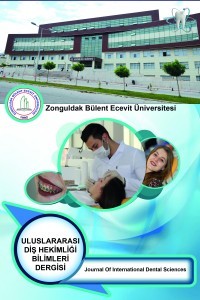Travma Sebebiyle Meydana Gelmiş Oronazal Fistülün Cerrahi Tedavisi: Vaka Raporu
Bu vaka raporunda travma sebebiyle oronazal fistül gelişen hastanın cerrahi olarak tedavi edilmesi olgusu sunulmuştur. Otuz yedi yaşındaki erkek hasta çocukluk çağında sert damak bölgesine çivi batması sonrası oluşan, birkaç defa dış merkezde opere edilmiş fakat kapanmayan fistül ve nazal konuşma şikayetiyle Bülent Ecevit Üniversitesi Diş Hekimliği Fakültesi Ağız, Diş ve Çene Cerrahisi Anabilimdalına başvurdu. Yapılan intraoral muayene ve bilgisayarlı tomografi değerlendirmelerinde oronazal fistül tespit edildi. Hastanın bilgilendirilmesinden sonra genel anestezi altında two-flap cerrahisi ve iki tabakalıı yumuşak doku kapatması sağlandı. Hastanın post-op 3. Gün, 1. Hafta, 1. Ay ,3. Ay ve 6. Ay kontrollerinde herhangi bir açıklık ve komplikasyona rastlanmadı. Hastanın şikayetleri cerrahi sonrasında ortadan kaldırıldı. Kullanılan iki tabakalı kapatma yöntemiyle başarılı bir sonuca ulaşıldı.hastanın fonasyonunda iyileşme meydana geldi.
Anahtar Kelimeler:
Oronazal fistül, Two-flap, Fonasyon
Surgical Treatment of Traumatic Oronasal Fistula: Case Report
In this case report, surgical treatment of a patient who developed an oronasal fistula due to trauma was presented A thirty-seven year old patient was referred to Zonguldak Bülent Ecevit University Oral and Maxillofacial Surgery department who has oronasal fıstula on middle palate. He had a travma history with a nail on his palate when he was child. The patient had operated several times before referred to our department. Oronasal fistula was detected in intraoral examination and computed tomography evaluations. After informing the patient, we performed two-flap under general anesthesia. Two-layer closure was performed for the treatment of the defect. Post-op 3rd, 7th, day and 1, 3, 6 months controls done and there were no complications found. The patient´s complaints solved after surgery. Closure of oronasal fistula by two layers of mucoperiosteal flaps was succesfull and the patient had better fonation.
Keywords:
Oronasal fistula, Two-flap, Fonasyon,
___
- 1. Posnick JC, Getz SB. Surgical closure of end-stage palatal fistulas using anteriorly-based dorsal tongue flaps. Int J Oral Maxillofac Surg. 1987;45(11):907-12.
- 2. Abdel-Aziz M, Hegazi M, Ghandour H. Velopharyngeal dysfunction. Handbook of Pharyngeal Diseases New York, NY: Nova Science. 2010:109-35.
- 3. Moghe S, Gupta M, Pillai A, Nahar S, Arun A. Repair of Oronasal fistula with Split-thickness Palatal graft. IOSR Journal of Dental and Medical Sciences. 2014;13:89-92.
- 4. Richardson S, Agni NA. Palatal fistulae: a comprehensive classification and difficulty index. Journal of maxillofacial and oral surgery. 2014;13(3):305-9.
- 5. Abdel-Aziz M. V–Y two-layer repair for oronasal fistula of hard palate. International journal of pediatric otorhinolaryngology. 2010;74(9):1054-7.
- 6. Cohen SR, Kalinowski J, LaRossa D, Randall P. Cleft palate fistulas: a multivariate statistical analysis of prevalence, etiology, and surgical management. Plast Reconstr Surg. 1991;87(6):1041-7.
- 7. Diah E, Lo L, Yun C, Wang R, Wahyuni LK, Chen Y. Cleft oronasal fistula: a review of treatment results and a surgical management algorithm proposal. Chang Gung medical journal. 2007;30(6):529.
- 8. Sadhu P. Oronasal fistula in cleft palate surgery. Indian journal of plastic surgery: official publication of the Association of Plastic Surgeons of India. 2009;42(Suppl):S123.148- Yang H, Gao LN, An Y, Hu CH, Jin F, Zhou J, Jin Y, Chen FM. Comparison of mesenchymal stem cells derived from gingival tissue and periodontal ligament in different incubation conditions. Biomaterials 2013; 34: 7033-7047.
- ISSN: 2149-8628
- Yayın Aralığı: Yılda 3 Sayı
- Yayıncı: Zonguldak Bülent Ecevit Üniversitesi
Sayıdaki Diğer Makaleler
İki Rezin Simanın Farklı Metal Alaşımlara Makaslama Bağlanma Dayanımlarının Karşılaştırılması
Hilal ŞİRİNER GÜMÜŞ, Güler YILDIRIM, Gülhan KARAASLAN
Yatay Alveoler Distraksiyon Osteogenezi Tekniğinde Yeni Kemik Oluşumu
GUMMY SMİLE’DA ETKİN ÇÖZÜM: BOTOKS
Süt Dişlerine Gelen Travmalara Bağlı Daimi Dişlerde Oluşan Gelişimsel Defektler: Üç Olgu Raporu
Travma Sebebiyle Meydana Gelmiş Oronazal Fistülün Cerrahi Tedavisi: Vaka Raporu
